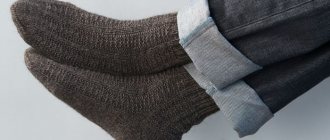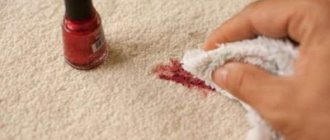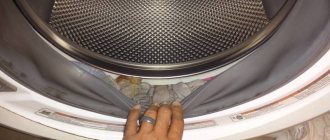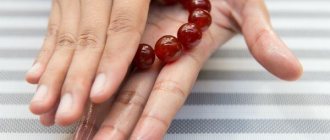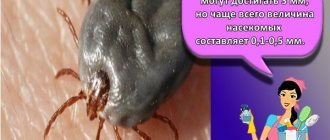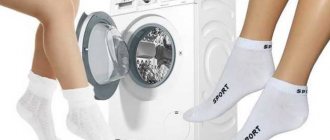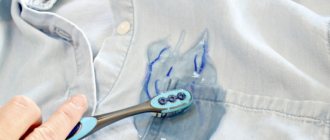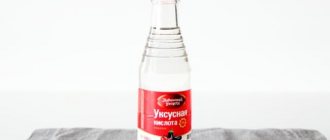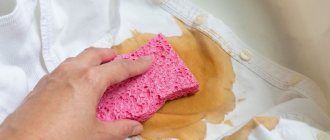It is easy to get infected with nail fungus, but it is difficult to get rid of it. Even multi-month therapy is not always successful, and the reason may be hidden in re-infection.
Few people realize, but the source of mycelium is often ordinary socks. To prevent the progression of the disease and not infect other people, they need to be washed correctly.
We will tell you in this article how to properly wash socks if you have foot and nail fungus.
Why do you need to treat socks and shoes for fungus?
Washing socks for nail fungus
Re-infection with this unpleasant disease is not uncommon. It's all about the transmission routes. The fungus lives on tiny scales of skin and nails, which accumulate in large quantities on clothing and objects in contact with the damaged area. Therefore, for mycosis of the toenails, special attention should be paid to such preventive measures as washing socks. If socks and shoes are not treated properly, the disease will return again and again. Of course, it is better to throw out the socks, but treatment may take several months, so in order not to buy new pairs every day, you should know how to properly wash socks if you have fungus.
What happens if you do not disinfect the things of a person suffering from mycosis of the nails and feet?
If you do not subject your socks to additional treatment, it will be difficult to cope with the infection.
Firstly, a person will constantly infect himself, so medications will be ineffective . Secondly, it will act as a spreader of the disease. Healthy people may suffer from this.
The fight against fungus must be comprehensive. Proper washing of socks is an important element of the overall treatment regimen. If after 6 months of continuous therapy it was not possible to cope with onychomycosis, you should consult a dermatologist.
Hand wash
Hand washing socks for mycosis
When washing by hand, you can pay more attention to treating those areas that have been in more contact with foci of mycosis. Moreover, if you have taken off your clothes, but do not plan to wash them right away, you should store them in a separate cellophane place. It is unacceptable to store used clothes, and especially socks, together with the belongings of healthy household members. In this case, it is best to pour 1-2 tablespoons of any antiseptic for linen into the same bag. Regular washing powder will also work.
When washing by hand, it is extremely important to take precautions so that fungal spores do not get on your hands - otherwise you may well get onychomycosis and nail fungus on your hands. Wash socks only with gloves, and be sure to pre-soak them in special solutions or other liquids that kill fungus.
Basic rules for hand washing:
- Soaking socks is mandatory - at least for an hour.
- Socks should be washed daily; if this is not possible, store dirty laundry in a separate bag with an antiseptic.
- Use gloves to prevent infection of other parts of the body.
- Washing powder without pre-soaking and ironing does not destroy spores during hand washing.
- Boil your socks before washing at least once every 3-5 days.
After complete recovery, all socks that you wore during the illness should be disposed of. As long as you treat your nails with special creams and ointments during illness, the likelihood of infection is reduced. When you stop treating your nails, your nails become more susceptible to recurrent athlete's foot.
For the manual washing method, choose stronger powders, since, for example, children’s ones are not able to cope not only with spores, but also with the fungus itself.
Recommendations
To ensure that clean socks do not get lost in the house, immediately after drying they can be folded in pairs, wrapping the elastic of one on top of the other. This way they will always be together in the laundry drawer, and you won’t have to waste extra time looking for them. Plastic clips will also help make folding easier.
- Before washing nylon socks, you can fold them one into one - they will not only become clean, but also retain their shape.
- There is no need to delay washing colored and light-colored socks. Fresh stains are much easier to remove than stubborn stains. Therefore, it is recommended to wash each pair after one use. If you wear them repeatedly, an unpleasant odor may appear. This will cause the old dirt to dry out and make it more difficult to remove.
- After washing, some models of socks may change their size - stretch or shrink. After a few minutes of wear, they will return to their original appearance.
Sorting items by color, pre-soaking and selecting the correct washing mode will result in clean, fresh socks. The use of plastic clips will save housewives from endless searches for a pair.
Machine washable
Machine washing socks for nail fungus
Machine washing socks for foot fungus is preferable. Its big advantage is the ability to set a high temperature, as well as pre-soaking.
Main rules for machine washing:
- Don't wash your socks in the same pile. Always wash them separately from the laundry of other household members.
- Choose the highest temperature possible – 90 degrees.
- If the machine has a Boiling or Bacterial mode, this is the best choice if you are sick.
- When washing with a machine, you can add an antiseptic solution directly to the drum, which will destroy most of the harmful bacteria and parasites.
You can also use the pre-soak mode.
Preparatory stage
Contaminants dry quickly and are absorbed into the fabric. It will be more difficult to remove dirt later, so you can’t delay washing.
It doesn't matter how you plan to wash your socks. The first thing to do is to thoroughly shake out dust and various debris from inside and outside.
The next stage is sorting things based on color and type of fabric. Black and dark ones can be safely thrown into the washing machine, adding a pair of jeans or other dark clothes. White socks will be more difficult to wash. It is better to pre-soak them, thoroughly soap them with laundry soap, and then put them in a basin without water overnight.
Periodic use of bleaches is allowed. This will help white items retain their color. When it comes to colored socks, it is better to wash them by hand, but always separately from other clothes, since the fabric can fade.
As for the material of the socks, most are machine washable. It is recommended to wash woolen products only by hand! Mechanical impact will contribute to the appearance of pellets and various deformations.
The preparation stage largely depends on the degree of contamination. If the socks are not very dirty, they can be washed immediately. Otherwise, pre-soaking cannot be avoided.
Washing with soap and soda solution
A soap-soda solution perfectly removes fat and sweat, which are an ideal environment for the development and growth of fungus. In addition, this solution perfectly kills the fungus itself, thinning its shell. As a result, protein bonds are destroyed and mycosis disappears. How to use soap and soda solution? There are two ways:
Soap and soda solution for washing socks with mycosis
- For soaking things. Before washing in the washing machine, place the socks in a basin, fill with hot water, and grate laundry soap on a coarse grater - about 100 grams. Add 200 grams of baking soda, mix the solution thoroughly until completely dissolved. The amount of soda and soap is given for 10 liters of water. Soak your socks in this solution overnight, and in the morning wash them in the washing machine at 90 degrees.
- Boiling in a soap-soda solution. For 10 liters of water, put 1 grated bar of soap weighing 100-150 grams and a pack of baking soda. We put it on fire. Place socks or other items that need to be washed in a container with the solution and bring to a boil. Reduce the heat and cook them for five minutes. This procedure reliably destroys fungus and dirt, and completely disinfects things.
A little of this solution can be added to the machine when washing, it will soften the water and remove more stains.
How to wash properly
In the washing machine
When choosing a mode for washing socks in a washing machine, you need to take into account the type of fabric. Cotton socks wash well using the “boiling” mode at high temperatures.
For products made of synthetics and nylon, the water temperature should not exceed 40 °C. Experienced housewives recommend using products that contain enzymes. The best washing powders:
- "Reflect"
- "Omo intelligent-automat"
- "Ariel-automat"
Due to hygiene requirements, it is not recommended to put socks in the washing machine together with underwear, handkerchiefs, towels, and jeans.
Handwash
Hand wash your socks with care. Hosiery items should not be pulled or twisted, as they may lose their shape.
For hand washing, you should prefer biopowders that perfectly remove protein and grease stains:
- "Spring Tenderness"
- "Sorti super economy bio"
You can wash your socks using an ordinary two-liter jar. Pour water into it, add a little powder, put socks and close the lid. In this form, they can be left to soak for several hours, and then shaken vigorously.
Washing with laundry soap
Laundry soap
Laundry soap is a fairly powerful alkali that is an antiseptic. It destroys the fungus and prevents it from spreading to other parts of the body. Therefore, washing with laundry soap is an excellent option for destroying fungus on socks and other clothes. When washing, you should follow several rules:
- Before washing, socks should be soaked in soapy water or boiled.
- After washing, it is advisable to iron the socks.
This method of washing socks with laundry soap has proven itself to be excellent. Wet the socks with water, wring them out well and rub each area with soap. Leave for 5 hours, after which we wash them using the usual method - by hand or in a machine. With this method, the fungus will be exposed to a fairly strong alkali, practically undiluted with water. This means that its bactericidal properties will be fully revealed.
If wool products
Woolen items turn yellow over time. How to bleach white socks, sweaters, and wool jackets correctly at home? Things are soaked in special bleaches: “Vorsinka”, “Laska”. Products containing chlorine are not suitable. They destroy fiber and are harmful to hands and nails. You can use oxygen bleach or make your own solution using the following ingredients at home:
- boric acid 1 sachet 20 g and 10 l of water; leave the products in the solution for an hour;
- for a bucket of water - a glass of salt, 30 ml of peroxide and ammonia, 30 g of washing powder: combine all the ingredients together in a basin, pour in water, make a solution, soak woolen items for 4 hours;
- 400 g of chalk per 3 liters of warm water; the products are left in the solution for 40 minutes, rinsed thoroughly; items are pre-washed by hand or in a machine; soda is often added to the solution;
Stains on wool socks can be treated with a spray before washing.
Pay attention to the composition of the product: it should not contain chlorine
Rubbing wool socks is not right. They should be washed by lightly wringing the item by hand, and not in the washing machine. Woolen items should not be washed together with cotton or synthetic items.
Soaking socks
One of the mandatory procedures when washing socks is pre-soaking them. It can be carried out in various solutions, which not only destroy the microorganisms themselves, but also deprive clothing items of a breeding ground for fungi and bacteria - sweat, fat, skin flakes.
With vinegar
Soaking in vinegar
Soaking socks in a vinegar solution gives an excellent effect in disinfecting the things of a patient with fungus. Soaking solution recipe:
5 liters of water, 150 grams of vinegar. It is better to take natural apple cider vinegar at least 6%. The water for soaking must be preheated - this will enhance the effect by an order of magnitude.
Soaking should be carried out before standard washing for 5 hours. Remember that the acid contained in vinegar thins the thread, making it less strong. Therefore, do not leave socks in the solution for longer than a day.
40% vinegar essence also helps a lot. When washing socks in it, you need to protect your hands with gloves.
With chlorine solution
Before use, make sure that your fabric will not be damaged; there should be a note on the tag that the laundry can be washed with the addition of chlorine. Colored socks may vary in color.
Recipe: for 5 liters of water you need to take 1-2 tablespoons of chlorine, stir well until completely dissolved. Dip socks into the solution and leave for at least 1 hour. Bleach destroys fabric when soaked for a long time, so you should not keep your laundry in this solution for more than 2-3 hours. You can also add a ready-made solution containing chlorine to the water; it acts more gently on fabric and also helps to effectively remove fungus from clothes.
When washing in a chlorine solution, you must use gloves to protect your hands.
Removing gray spots and yellowness
As a result of frequent washing, light-colored items tend to darken and lose their former appearance. In this case, do not rush to throw away your socks.
There are several miraculous ways to help restore your snow-white appearance:
- Severely grayed items can be bleached using turpentine. Take 3 tablespoons of liquid with a pungent odor and dilute it in a 10-liter bucket of water, adding a few tablespoons of regular washing powder. After thoroughly stirring, leave the items in the resulting mixture overnight, then wash as usual.
- Chlorine-containing products also do an excellent job of removing gray spots and yellow discoloration. However, they can only be used on clothing items made of cotton. Pour 2 tablespoons of liquid into 2 liters of water and add 100 grams of washing powder. After thoroughly mixing the mixture, leave the clothes in it for one night, then wash them.
- You can make a stain remover at home using hydrogen peroxide and ammonia. To do this, mix the ingredients in proportions of 1 to 2 and apply the mixture to problem areas.
- Another bleaching method is to use a mixture of laundry detergent and dishwashing detergent. To prepare it, you need to squeeze out a few drops of washing liquid into one tablespoon of powder and foam it. Apply the solution directly to stubborn stains and wash with your hands after 10-15 minutes.
- An equally effective way to return things to a presentable appearance is to use special stain removers. A wide range of store-bought products offer many different ingredients for whitening items. When using stain removers, it is recommended to follow the instructions exactly to avoid unforeseen situations.
Please note that it is advisable to dry things away from sunlight. Otherwise, the yellowness may return and it will no longer be possible to remove it.
The best option would be to dry it outside in the shade, which will also help rid things of a specific smell.
Antiseptics in the form of sprays
In order to carry out antiseptic treatment of socks and shoes against fungus, the industry offers various chemicals for disinfection. The most common of them are Avestil, Alaminol, Barrier, Deactivate, Megadez. They are produced mainly in the form of sprays, so they are convenient to use for washing and treating socks and shoes.
Specially developed antiseptic sprays have the following advantages:
- Quite powerful, they destroy fungus, bacteria, and viruses.
- If things can be damaged when soaking, then the spray is specially designed for use.
- Some items cannot be washed, such as shoes. Sprays are an ideal option for them.
- Sprays are also safe for humans - they do not affect his health if the rules of use are followed.
- A universal treatment tool - they can be used to treat scissors, files, and other manicure products for treating nails and skin for mycosis.
Using special sprays is one of the best and easiest ways to clean fungus from socks. It must be applied before washing.
What to wash
To remove dirt from socks, there are no clear recommendations for choosing a detergent, and choosing it specifically for a particular pair is a whim.
The practical and easiest option is to wash it with other items that match the fabric composition and color. And for this prefabricated composition, you can already select the most suitable detergent.
To determine which fabrics a particular pair of socks belongs to, you need to take the time to look at the information on the product label. However, in order to properly wash socks there are some subtleties:
- White socks can be washed with other things, to which it is permissible to use bleach and powder with enzymes, which enhances the effect of bleaches;
- Laundry soap made from cotton fabric is perfect;
- products made from woolen materials will require special treatment - they must be treated with wool products;
- Synthetic products can easily be washed with any type of detergent.
Boiling
Boiling socks for fungus
The easiest and cheapest way to get rid of fungal spores in socks. It requires minimal effort. At the same time, you do not need to come into contact with substances that are hazardous to your health, such as bleach, and you do not need to buy such expensive substances as special disinfectant sprays.
Boiling can be carried out in clean ordinary water, or you can add various additional substances to it - soda, salt, hydrogen peroxide, vinegar. The main rule for a complete recovery without relapse is to treat socks before, during and after therapy.
Boiling is carried out for at least 5 minutes, but it is better to boil the socks for 15 minutes. This guarantees complete disposal of not only the fungus, but also their spores, which are quite tenacious.
Special means for disinfecting socks
As we wrote above, there are a lot of means for disinfecting socks and shoes. Let's look at the most popular of them.
Alaminol . A solution that can be used to disinfect not only socks, but also other clothes, manicure accessories, a bathtub, a basin for baths after fungus, and many other things. It is produced in the form of a blue concentrate, which has a weak, moderately pleasant odor. When soaking with alaminol, keep your socks in it for no more than 20 minutes. In this case, choose a less concentrated solution - five, eight or ten percent concentration.
Avestil . Consists of surfactants. The disinfectant effect is due to its composition. It includes Alkyldimethylbenzylammonium chloride (ADBAH) 5%, Glyoxal 8%, Auxiliary components, Surfactants. To destroy the fungus, socks are treated with a 2.5%, 3%, 5% solution for 30, 60, 90 minutes, respectively. This remedy is mainly used in hospitals and clinics, but can also be used at home.
Megadez . To destroy fungi from surfaces and clothing, 1% and 1.5% solutions are used. Soaking is carried out for a period of 60 and 90 minutes, respectively. The product is very concentrated and can cause tissue destruction, so when soaking, the solution is diluted with water.
Chlorhexidine . Under its influence, many harmful bacteria and fungi die from soft fabrics, furniture and clothing. It is part of many antifungal drugs. It is a colorless, transparent liquid with an alcoholic odor. Used when washing or soaking underwear, socks and other things.
There are many chemical disinfectants. In addition to those described above, substances based on silver ions have also gained particular popularity. They have antifungal properties and are able to destroy pathogenic bacteria.
Chlorhexidine or Miramistin?
The leader in the pharmacy top list is treatment with chlorhexidine. It has a lot of advantages: the product has no odor, does not damage shoes, dries quickly and leaves no marks. You can use it in two ways.
First: take out the insoles, wipe them with a swab dipped in the solution. Then we wipe the inside of the shoes and leave them to dry. Second method: buy chlorhexidine spray or pour it into a spray bottle. Then we spray the inside of the shoes or sneakers.
Some reviews claim that pharmacy chlorhexidine has too low a concentration (0.05%), so it will not completely destroy the infection on the legs. A 1% solution is required, but it is not so easy to find on sale. In this case, the more powerful antiseptic Miramistin will come to the rescue. It should be used according to a similar scheme (as with chlorhexidine), daily. The only drawback of the product is the price (from 200 rubles).
On medical forums you can find opinions that Miramistin is a more expensive version of chlorhexidine. In fact, this is not so - both drugs have different composition and effectiveness. Which one to use is up to you.
Ironing socks
Ironing socks kills fungus
After you have washed your socks and disinfected them, you need to carry out one more manipulation that will kill the fungus completely. Socks should be ironed on both sides. High temperature destroys not only the fungus, but also the spores. At the same time, low temperatures have no effect on mycosis at all. You should not take wet washed clothes out into the cold, as this will not bring any results.
Steam treatment of laundry and high temperatures has also proven itself to be excellent. When ironing, iron on both sides.
Using special shoe inserts
Science does not stand still. Special ultraviolet liners have been produced to disinfect socks and shoes. They need to be inserted inside shoes or socks at night. The price of the liner is low, but they have a lot of advantages:
- safe for both things and people.
- Ideal for drying shoes.
- Not affected by chemicals.
- Completely environmentally friendly.
- Destroys not only fungi, but also bacteria, viruses, and spores.
After using the inserts, the shoes remain exactly the same as before use - without foreign odors, color changes, and so on.
The only negative is the processing time. If this is justified in disinfecting shoes, then it is easier to simply replace socks.
Adviсe
Treatment is not a treatment method. A person must use special creams and ointments to kill the fungus.
Immediately after finishing the treatment, the socks will need to be thrown away. When using special medications, the likelihood of re-infection is reduced. When a person stops rubbing the compounds into the nail plate, the remaining spores can lead to a relapse of the disease.
All rules for disinfecting socks must be followed. Even small violations of technology can lead to undesirable consequences.
Whiteness for washing socks
Whiteness for washing
Light natural socks can be washed white. On colored people it can eat away the paint, but it does an excellent job of destroying fungus. It owes these qualities to the 8% chlorine solution contained in the cleaning product. White also contains sodium hypochloride (NaOCl), alkalis and various fragrances, which slightly mask the smell of active chlorine.
How to wash socks in white
- Add a little bleach to the water, stir well, and add the laundry.
- Leave socks and other items for 15-20 minutes.
- Wash your socks in this solution.
- Rinse thoroughly with water to remove all chemicals from the fabric.
Do not forget that whiteness is a rather toxic and poisonous substance, so when washing it is extremely important to protect your hands with gloves.
Reviews
- Nina: “My husband caught nail fungus, and I was very afraid that it would infect both me and the children, so first of all, I immediately began looking for information on how to avoid it. I learned that socks should be washed daily, separately from general laundry, and it is advisable to soak them in a bactericidal solution or boil them. I did so. During my illness, my husband wore 3 pairs of socks in turn, and I first soaked them in water with the addition of Domestos, and then simply washed them by hand. No one got infected here, and the disease went away without relapse the first time.”
- Mikhail “I live in a dorm, and I don’t have a washing machine here yet. I also caught a fungus. The doctor said that you need to wash your socks every day, and not just wash them, but boil them and iron them. Honestly, I was too lazy to do this, so I made this solution: I poured a capful of toilet detergent with chlorine into about 2 liters of water, left it for 15 minutes, and then washed it with laundry soap. At the same time, I constantly treated my nails with ointments. I was cured in 3 weeks and threw out my socks.”
Methods for removing pellets
After washing, pills appear on socks. They spoil the appearance of products, so it is advisable to get rid of them.
Reasons for appearance
Fibers roll off not only from washing, but also from improper wearing. On woolen fibers, twisting of the fibers occurs at first. Synthetics and cotton shrink over time for a variety of reasons.
Wrong washing mode
There will be fewer abrasions on the front side if you turn the socks inside out before putting them in the machine. Items made from wool should be washed by hand or set to the “Delicate Wash” mode. Do not overfill the drum with dirty laundry to avoid strong friction.
Using the wrong means
Do not use abrasive products on socks. Washing liquids or laundry soap shavings are best. Detergent particles will stick to fabrics, causing pilling.
Intense friction
When you rub the dirty area with your hands, the friction causes the fibers to twist and balls to appear on the surface of the fabric. It is better to soak the laundry so that the dirt disappears, and then wash it carefully, without rubbing.
Schweiler
A special machine can easily cut pellets from fibers
When choosing a device, pay attention to its ease of use. The machine has a cutting height adjuster
Thanks to it, the fibers are not damaged. Treat the surface of the socks in a circular motion.
Shaver
You can remove pellets from your socks with a razor.
At the same time, pay attention that the blade is not too sharp. It is better to cut balls in this way from dense, non-embossed woolen fabrics.
Scotch tape, band-aid or adhesive tape
It is easy to remove pills from synthetic fabrics with tape or adhesive tapes. You need to tear off the glued strip with sharp movements. A suitable method for eliminating dense balls.
